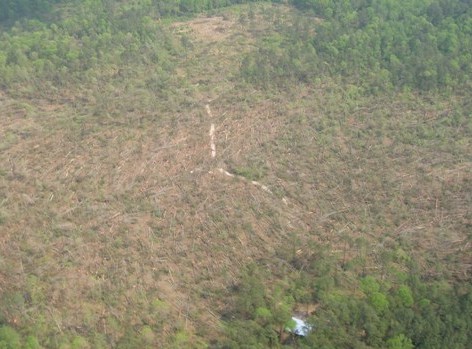
Courtesy N.C. Forest Service
The health of North Carolina’s forests can be negatively impacted by a number of factors such as wildfire, insects and diseases. Elements such as these are a major threat to forest resources with insects and diseases claiming more timber each year than any other forest menace. In many cases, these influences are driven, almost encouraged, by human activity.
Human behavior accounts for 99 percent of all wildfires in North Carolina by means of escaped debris burns, campfires, fireworks, incendiary and machine and vehicle use. By moving untreated firewood, folks are contributing to the spread of tree destroying insects, helping them reach their next area of infestation. Soil and plant material containing traces of disease can be transported by unsanitary tools, equipment, vehicles and even shoes. More land is being taken out of production as many healthy and highly productive forests are cutover for a quick profit, then left idle while thousands of acres are lost each year to poor forest management.
A danger that’s even more prevalent that appears in many forms is weather.
Forest health in North Carolina is negatively impacted by storms and other weather events such as hurricanes (Atlantic hurricane season spans June 1 to Nov. 30) tornadoes, ice storms, drought, excessive rainfall, sea level rise and other weather events, which are predicted to increase in the future as outlined in the North Carolina Forest Action Plan.
Tree-damaging storms occur across North Carolina and thunderstorms frequently leave tree damage in their wake while less frequent tornadoes, ice storms and hurricanes inflict serious and widespread tree damage. As these major weather events impact forest resources, they’ll continue to pose challenges to traditional forest management strategies and potentially compound other forest threats.“Most of North Carolina’s forest insects are secondary, meaning the insect follows some sort of stressor,” explained Wayne Langston, forest health specialist with the N.C. Forest Service. “When a storm occurs and puts that additional stress on a tree or group of trees, secondary insects such as the ips engraver beetle can sense that stress and move to attack that tree along with the surrounding trees.”
Ips engraver beetles have been highly active throughout the state in recent years, attacking stressed pine trees along the way. However, storms are not the only factor.
Trees can become stressed from overstocking, periodic drought, excessive soil wetness and other abiotic stressors, which are nonliving parts of an ecosystem such as wind, fire and weather.
Invasive plants have the same opportunity and access to move into certain areas and invade following storm damage. Chinese privet is an aggressive shrub that can be difficult to eradicate once established, growing anywhere from six to 15 feet in height and width.
“I’ve witnessed invasive species become more and more prevalent in my 34 years working with the N.C. Forest Service Forest Health Branch,” added Langston. “Anytime there’s a disturbance, there’s an increased risk of an invasive moving in and filling that void. Chinese privet can quickly occupy and take over an area where a stand has been blown down by high winds.”
Additional examples where weather impacts and prolonged storm damage is cause for concern resides in coastal areas and along tidally influenced rivers where salt intolerant trees have been impacted by salt depositions from storm surge, storm tides and evaporated sea spray, contributing to stunted growth, stress and scattered mortality. Or within the oak population, where mature oaks have increasingly declined over the past few years. Older trees weakened by oversaturation, soil compaction and prolonged drought have experienced weakened natural defense responses.
“Any damage caused by storms is devastating, especially when it’s your stand, tree or property that’s been impacted,” said Jim Moeller, another forest health specialist with the N.C. Forest Service — Langston and Moeller tag team the eastern Piedmont and Coastal Plain regions of North Carolina.
“Drought is challenging in more ways than one as it can go somewhat unnoticed in regard to trees,” Moeller added. “The consequence drought has on trees can be hard to track and may take years to manifest. Once drought stress reaches a certain point, trees become more susceptible to insect and disease attack
Eventually trees succumb to this cycle of piled up stress.
While options are limited when it comes to matters such as natural disasters, a healthy stand is still the best defense, even if far from a guarantee.
“Practicing good forest management will always be the best approach. Even then, things still happen when you’re up against the weather,” Moeller said.
Thinning a pine stand is a crucial component found in many forest management plans, improving forest health by reducing the risk of loss from disease, insects and wildfire. Thinning also allows the ground to receive additional sunlight which stimulates growth of grass, shrubs and other plants that may be beneficial to wildlife.
“A landowner may have just completed a thinning operation as recommended by their forester only to have a windstorm follow a short time later, leaving your stand more susceptible to being blown down, having not had enough time to become wind firm,” Moeller continued. “However, the risk of a blow down isn’t worth neglecting the importance of thinning.”
Site monitoring as well as aerial and ground surveys to assess storm damage will be critical for identifying and implementing future management solutions. Forest Health staff with the N.C. Forest Service conduct such surveys throughout the year and are available to provide additional support. Langston said folks can contact their local NCFS county office to help assess storm damaged trees and make recommendations.
Contact information for NCFS county offices is available at www.ncforestservice.gov/contacts. You can learn more about forest health in North Carolina at www.ncforestservice.gov/forest_health/forest_health.htm.






















